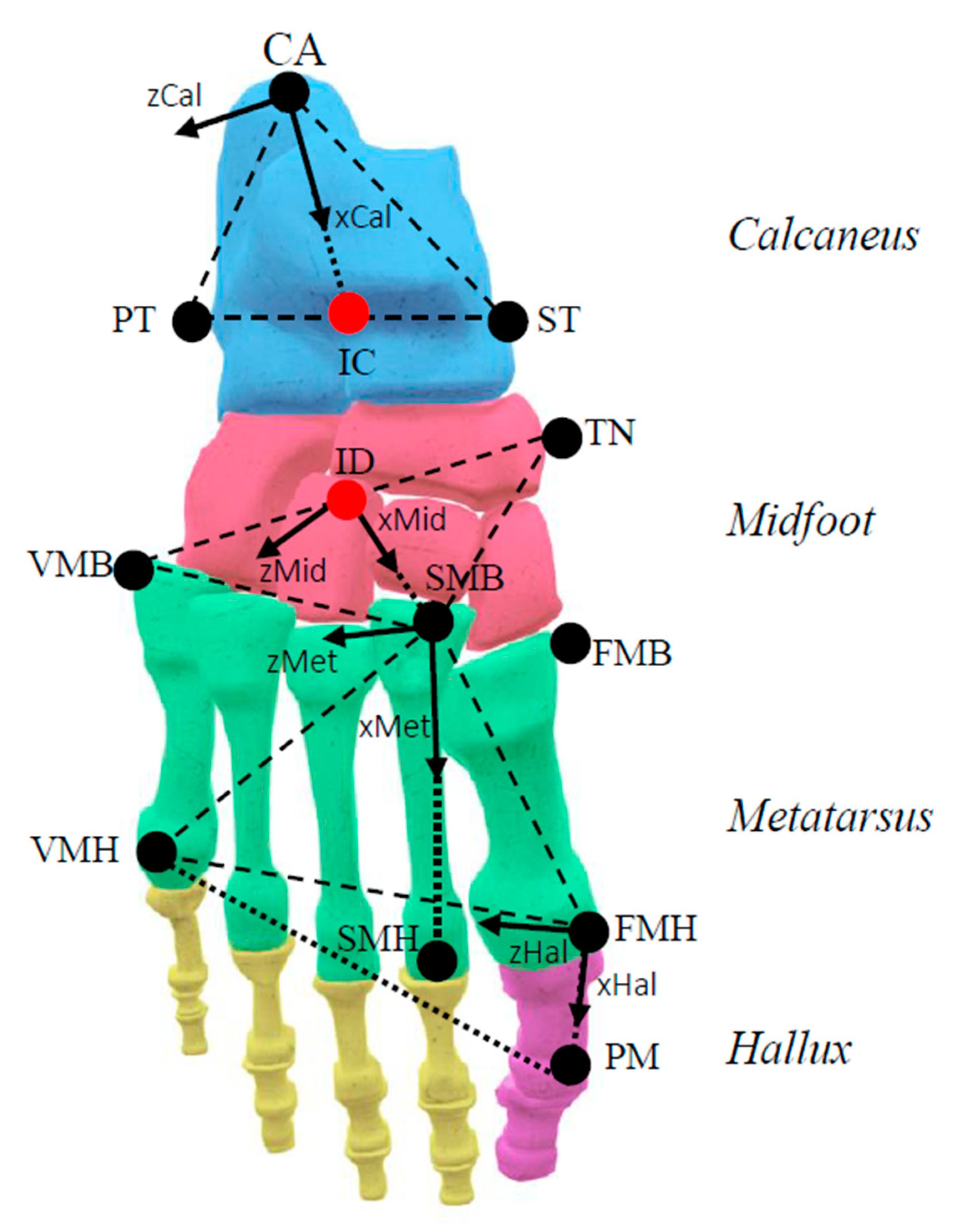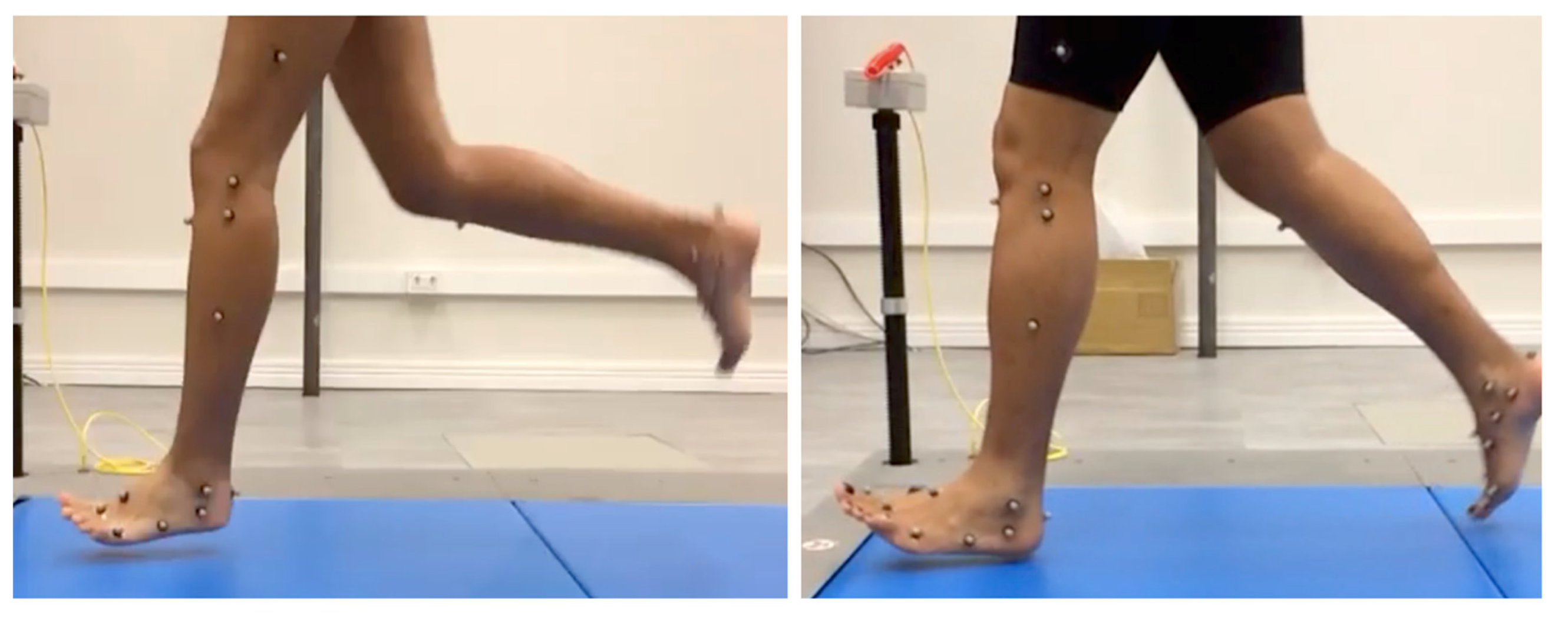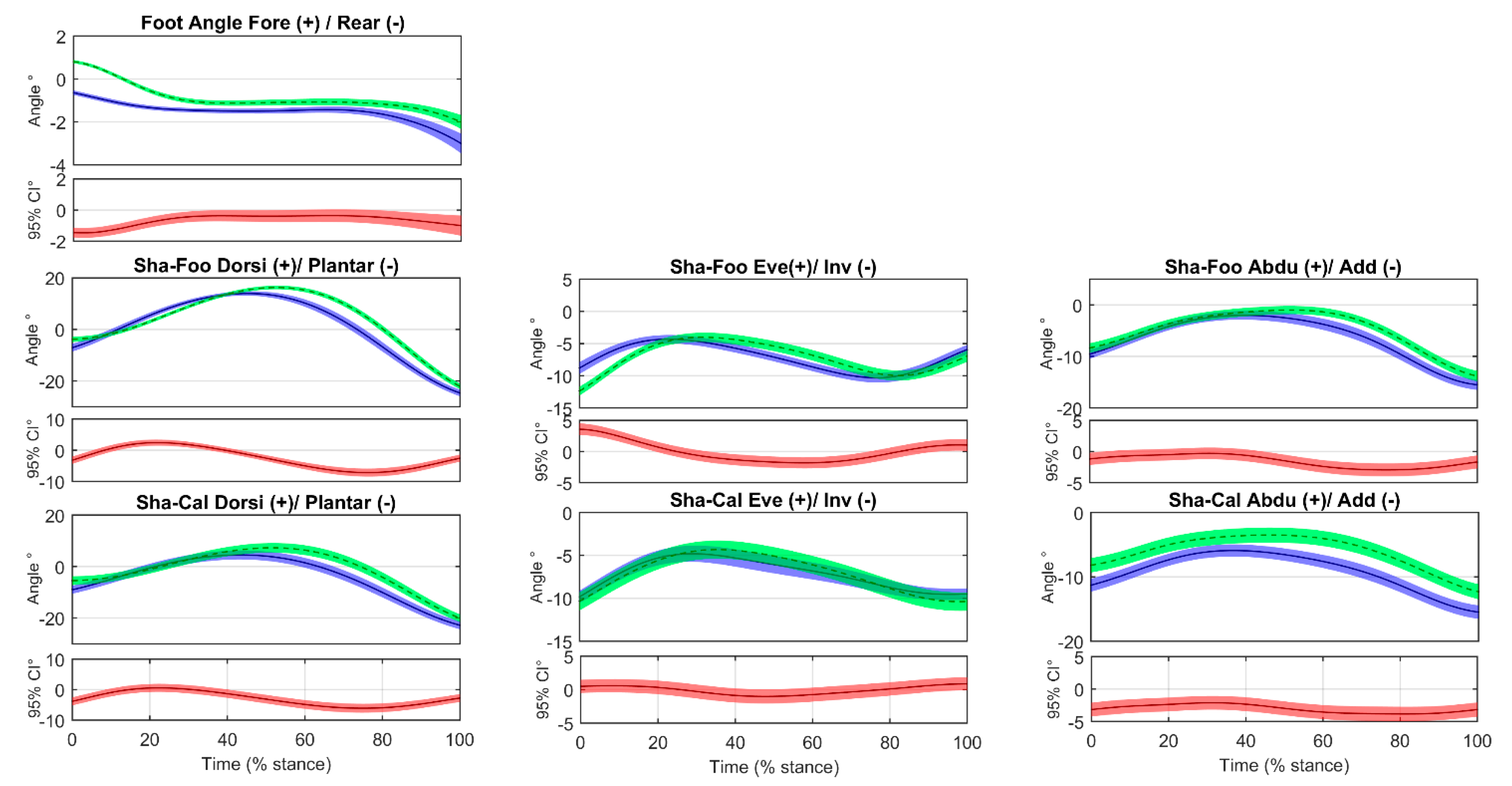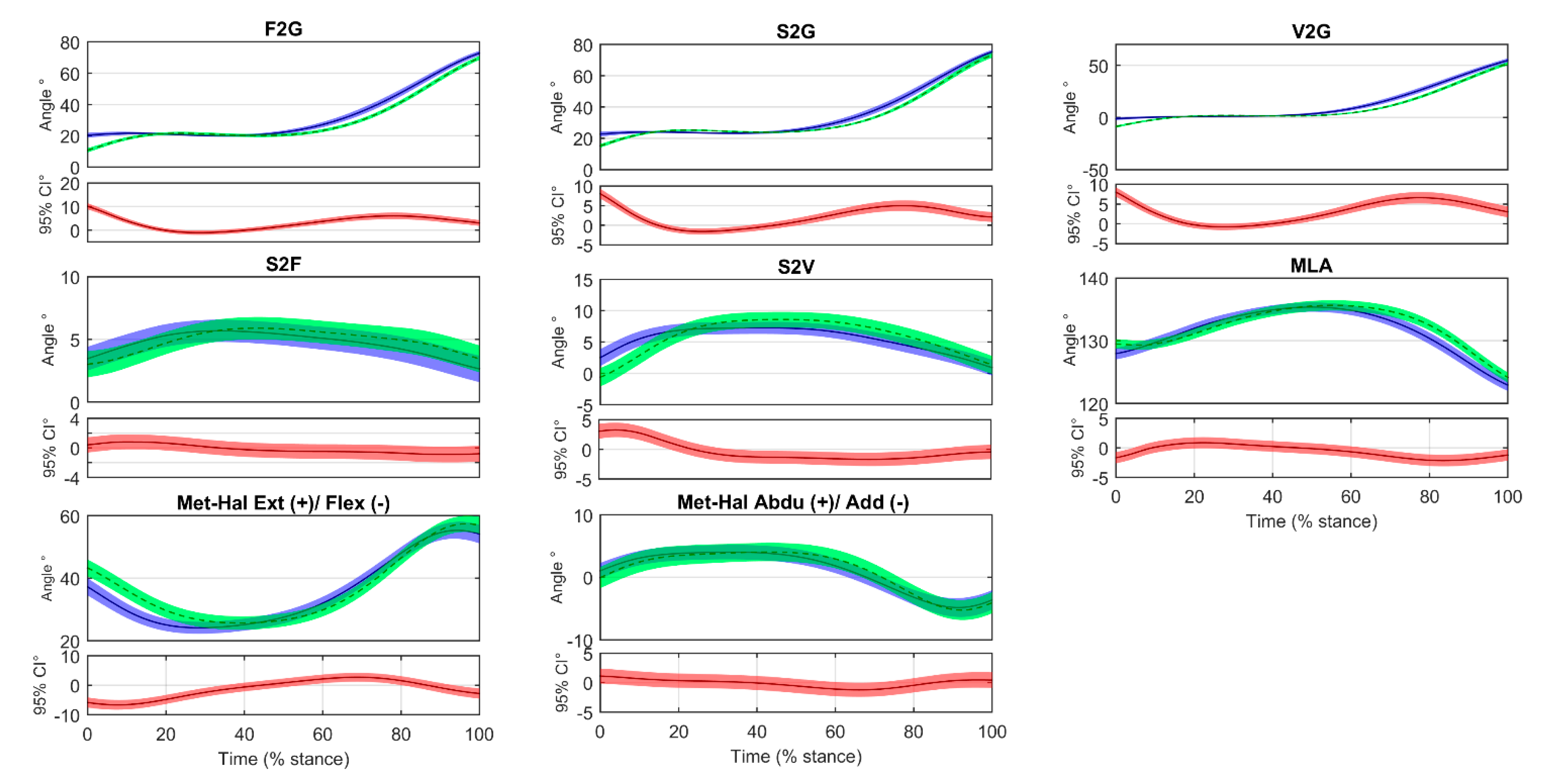Rearfoot, Midfoot, and Forefoot Motion in Naturally Forefoot and Rearfoot Strike Runners during Treadmill Running
Abstract
1. Introduction
2. Methods
2.1. Participants
2.2. Protocol and Instrumentation
2.3. Data Analysis
3. Results
4. Discussion
5. Conclusions
Author Contributions
Funding
Conflicts of Interest
Data Availability
Ethics Approval and Consent to Participate
References
- Davis, I.S.; Rice, H.M.; Wearing, S.C. Why forefoot striking in minimal shoes might positively change the course of running injuries. J. Sport Heal. Sci. 2017, 6, 154–161. [Google Scholar] [CrossRef] [PubMed]
- de Almeida, M.O.; Saragiotto, B.T.; Yamato, T.P.; Lopes, A.D. Is the rearfoot pattern the most frequently foot strike pattern among recreational shod distance runners? Phys. Ther. Sport 2015, 16, 29–33. [Google Scholar] [CrossRef] [PubMed]
- Almonroeder, T.; Willson, J.D.; Kernozek, T.W. The effect of foot strike pattern on achilles tendon load during running. Ann. Biomed. Eng. 2013, 41, 1758–1766. [Google Scholar] [CrossRef] [PubMed]
- Futrell, E.E.; Jamison, S.T.; Tenforde, A.S.; Davis, I.S. Relationships between Habitual Cadence, Footstrike, and Vertical Load Rates in Runners. Med. Sci. Sports Exerc. 2018, 50, 1837–1841. [Google Scholar] [CrossRef]
- Bowser, B.J.; Fellin, R.; Milner, C.E.; Pohl, M.B.; Davis, I.S. Reducing impact loading in runners: A one-year follow-up. Med. Sci. Sports Exerc. 2018, 50, 2500–2506. [Google Scholar] [CrossRef] [PubMed]
- Deschamps, K.; Eerdekens, M.; Peters, H.; Matricali, G.A.; Staes, F. Multi-segment foot kinematics during running and its association with striking patterns. Sport. Biomech. 2019, 00, 1–14. [Google Scholar] [CrossRef]
- Kelly, L.A.; Farris, D.J.; Lichtwark, G.A.; Creswell, A.G. The Influence of Foot-Strike Technique on the Neuromechanical Function of the Foot. Med. Sci. Sports Exerc. 2018, 50, 98–108. [Google Scholar] [CrossRef] [PubMed]
- Peters, H.; Deschamps, K.; Matricali, G.A.; Staes, F. Foot segmental mobility during subphases of running: Comparative study between two striking patterns. Gait Posture 2017, 53, 127–130. [Google Scholar] [CrossRef]
- Bruening, D.A.; Pohl, M.B.; Takahashi, K.Z.; Barrios, J.A. Midtarsal locking, the windlass mechanism, and running strike pattern: A kinematic and kinetic assessment. J. Biomech. 2018, 73, 185–191. [Google Scholar] [CrossRef]
- Almeida, M.O.; Davis, I.S.; Lopes, A.D. Biomechanical Differences of Foot-Strike Patterns During Running: A Systematic Review With Meta-analysis. J. Orthop. Sport. Phys. Ther. 2015, 45, 738–755. [Google Scholar] [CrossRef]
- Warne, J.P.; Warrington, G.D. Four-week habituation to simulated barefoot running improves running economy when compared with shod running. Scand. J. Med. Sci. Sport. 2014, 24, 563–568. [Google Scholar] [CrossRef] [PubMed]
- Leardini, A.; Benedetti, M.G.; Berti, L.; Bettinelli, D.; Nativo, R.; Giannini, S. Rear-foot, mid-foot and fore-foot motion during the stance phase of gait. Gait Posture 2007, 25, 453–462. [Google Scholar] [CrossRef] [PubMed]
- Portinaro, N.; Leardini, A.; Panou, A.; Monzani, V.; Caravaggi, P. Modifying the Rizzoli foot model to improve the diagnosis of pes-planus: Application to kinematics of feet in teenagers. J. Foot Ankle Res. 2014, 7, 754. [Google Scholar] [CrossRef] [PubMed]
- Queen, R.M.; Gross, M.T.; Liu, H.Y. Repeatability of lower extremity kinetics and kinematics for standardized and self-selected running speeds. Gait Posture 2006, 23, 282–287. [Google Scholar] [CrossRef]
- Grood, E.S.; Suntay, W.J. A joint coordinate system for the clinical description of three-dimensional motions: Application to the knee. J. Biomech. Eng. 1983, 105, 136–144. [Google Scholar] [CrossRef]
- Caravaggi, P.; Matias, A.B.; Taddei, U.T.; Ortolani, M.; Leardini, A.; Sacco, I.C.N. Reliability of medial-longitudinal-arch measures for skin-markers based kinematic analysis. J. Biomech. 2019, 88, 180–185. [Google Scholar] [CrossRef]
- Andrade, A.G.P.; Polese, J.C.; Paolucci, L.A.; Teixeira-salmela, L.F. Functional Data Analyses for the Assessment of Joint Power Profiles During Gait of Stroke Subjects. J Appl Biomech 2014, 30, 348–352. [Google Scholar] [CrossRef]
- Górecki, T.; Smaga, Ł. fdANOVA: An R software package for analysis of variance for univariate and multivariate functional data. Comput. Stat. 2019, 34, 571–597. [Google Scholar] [CrossRef]
- Manter, J.T. Movements of the subtalar and transverse tarsal joints. Anat. Rec. 1941, 80, 397–410. [Google Scholar] [CrossRef]
- Elftman, H. The transverse tarsal joint and its control. Clin. Orthop. 1960, 16, 41–46. [Google Scholar]
- Pohl, M.B.; Buckley, J.G. Changes in foot and shank coupling due to alterations in foot strike pattern during running. Clin. Biomech. 2008, 23, 334–341. [Google Scholar] [CrossRef] [PubMed]
- Williams, D.S.; McClay, I.S.; Manal, K.T. Lower extremity mechanics in runners with a converted forefoot strike pattern. J. Appl. Biomech. 2000, 16, 210–218. [Google Scholar] [CrossRef]
- Pohl, M.B.; Hamill, J.; Davis, I.S. Biomechanical and anatomic factors associated with a history of plantar fasciitis in female runners. Clin. J. Sport Med. 2009, 19, 372–376. [Google Scholar] [CrossRef]
- Zadpoor, A.A.; Nikooyan, A.A. The relationship between lower-extremity stress fractures and the ground reaction force: A systematic review. Clin. Biomech. 2011, 26, 23–28. [Google Scholar] [CrossRef] [PubMed]
- Leardini, A.; O’Connor, J.J.; Giannini, S. Biomechanics of the natural, arthritic, and replaced human ankle joint. J. Foot Ankle Res. 2014, 7, 8. [Google Scholar] [CrossRef]
- Araújo, V.L.; Souza, T.R.; Magalhães, F.A.; Santos, T.R.T.; Holt, K.G.; Fonseca, S.T. Effects of a foot orthosis inspired by the concept of a twisted osteoligamentous plate on the kinematics of foot-ankle complex during walking: A proof of concept. J. Biomech. 2019, 93, 118–125. [Google Scholar] [CrossRef]
- Blackwood, C.B.; Yuen, T.J.; Sangeorzan, B.J.; Ledoux, W.R. The midtarsal joint locking mechanism. Foot Ankle Int. 2005, 26, 1074–1080. [Google Scholar] [CrossRef]
- Okita, N.; Meyers, S.A.; Challis, J.H.; Sharkey, N.A. Midtarsal joint locking: New perspectives on an old paradigm. J. Orthop. Res. 2014, 32, 110–115. [Google Scholar] [CrossRef]
- Fischer, K.M.; Willwacher, S.; Hamill, J.; Brüggemann, G.P. Tibial rotation in running: Does rearfoot adduction matter? Gait Posture 2017, 51, 188–193. [Google Scholar] [CrossRef]
- McKlay, I.; Manal, K. Coupling Parameters in Runners with Normal and Excessive Pronation. J. Appl. Biomech. 1997, 81, 109–124. [Google Scholar] [CrossRef]
- Nigg, B.M.; Khan, A.; Fisher, V.; Stefanyshyn, D. Effect of shoe insert construction on foot and leg movement. Med. Sci. Sport. Exerc. 2014, 30, 550–555. [Google Scholar] [CrossRef] [PubMed]
- Cheung, R.T.H.; Rainbow, M.J. Landing pattern and vertical loading rates during first attempt of barefoot running in habitual shod runners. Hum. Mov. Sci. 2014, 34, 120–127. [Google Scholar] [CrossRef]
- Roper, J.L.; Harding, E.M.; Doerfler, D.; Dexter, J.G.; Kravitz, L.; Dufek, J.S.; Mermier, C.M. The effects of gait retraining in runners with patellofemoral pain: A randomized trial. Clin. Biomech. 2016, 35, 14–22. [Google Scholar] [CrossRef]
- Van Hooren, B.; Fuller, J.T.; Buckley, J.D.; Miller, J.R.; Sewell, K. Is Motorized Treadmill Running Biomechanically Comparable to Overground Running? A Systematic Review and Meta—Analysis of Cross—Over Studies. Sport. Med. 2020, 50, 785–813. [Google Scholar] [CrossRef]
- Sinclair, J.; Taylor, P.J.; Vincent, H. Multi-segment foot kinematics and plantar fascia strain during treadmill and overground running. Foot Ankle Online J. 2014, 7. [Google Scholar] [CrossRef]
- Bade, M.B.; Aaron, K.; McPoil, T.G. Accuracy of Self-Reported Foot Strike Pattern in Intercollegiate and Recreational Runners During Shod Running. Int. J. Sports Phys. Ther. 2016, 11, 350–355. [Google Scholar]






| Variable | RFS (n = 49) | FFS (n = 25) | Main Effect (p) |
|---|---|---|---|
| Male/female | 23/26 | 12/13 | p = 0.563 † |
| Age (year) | 41.3 (6.8) | 40.4 (6.0) | p = 0.558 * |
| Height (m) | 1.68 (8.8) | 1.70 (9.6) | p = 0.198 * |
| Body mass (kg) | 68.7 (12.0) | 71.7 (14.6) | p = 0.348 * |
| Running volume (km/week) | 18.9 (14.1) | 19.2 (17.8) | p = 0.842 * |
| Foot Posture Index (median, min: max) | 1, –7: +9 | 3, –4: +8 | p = 0.371 # |
| Self-selected speed (km/h) | 9.8 (1.2) | 9.2 (1.3) | p = 0.080 * |
Publisher’s Note: MDPI stays neutral with regard to jurisdictional claims in published maps and institutional affiliations. |
© 2020 by the authors. Licensee MDPI, Basel, Switzerland. This article is an open access article distributed under the terms and conditions of the Creative Commons Attribution (CC BY) license (http://creativecommons.org/licenses/by/4.0/).
Share and Cite
Matias, A.B.; Caravaggi, P.; Taddei, U.T.; Leardini, A.; Sacco, I.C.N. Rearfoot, Midfoot, and Forefoot Motion in Naturally Forefoot and Rearfoot Strike Runners during Treadmill Running. Appl. Sci. 2020, 10, 7811. https://doi.org/10.3390/app10217811
Matias AB, Caravaggi P, Taddei UT, Leardini A, Sacco ICN. Rearfoot, Midfoot, and Forefoot Motion in Naturally Forefoot and Rearfoot Strike Runners during Treadmill Running. Applied Sciences. 2020; 10(21):7811. https://doi.org/10.3390/app10217811
Chicago/Turabian StyleMatias, Alessandra B., Paolo Caravaggi, Ulisses T. Taddei, Alberto Leardini, and Isabel C. N. Sacco. 2020. "Rearfoot, Midfoot, and Forefoot Motion in Naturally Forefoot and Rearfoot Strike Runners during Treadmill Running" Applied Sciences 10, no. 21: 7811. https://doi.org/10.3390/app10217811
APA StyleMatias, A. B., Caravaggi, P., Taddei, U. T., Leardini, A., & Sacco, I. C. N. (2020). Rearfoot, Midfoot, and Forefoot Motion in Naturally Forefoot and Rearfoot Strike Runners during Treadmill Running. Applied Sciences, 10(21), 7811. https://doi.org/10.3390/app10217811






